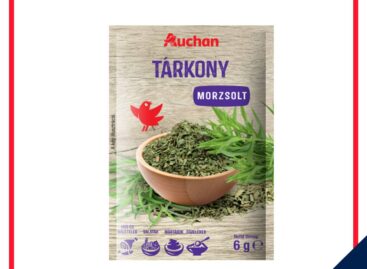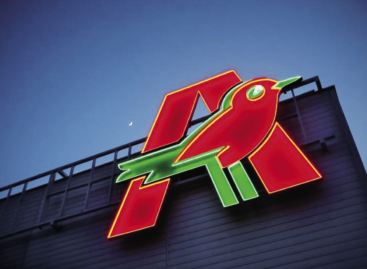Promotional television commercials from a neuromarketing perspective

Guest author:
Krisztina Polgár-Szabó
senior insight consultant
Synetiq
There is fierce competition between brands and service providers, and companies have great influence on the decisions of consumers. It isn’t an easy job to conquer the hearts of consumers, but one thing is sure: brand building work and promotional activities must be in harmony with each other – and efficient communication is essential for both. In the past few years Synetiq analysed the emotional and the conscious-level effects of many promotional commercials, to get a comprehensive picture of what works and what doesn’t. What makes a commercial successful?
Engagement curve
It shows to what extent the commercial can get and keep viewers engaged – Synetiq examines this by using a heart rate measurement device (yellow colour marks this).
1. The commercial and the ‘story’ are able to grab the attention of viewers and engage them emotionally
If a commercial was able to catch the attention of viewers already with the first scene, it was more likely that they paid attention to the promotional scene at the end of the short film.
1st example: Coca-Cola – 40 s – Prize game with a promotion (2021)
What does the engagement curve say? The story leading up to the promotion was interesting to 18-29 years old viewers. Although they got a bit tired by the end of the commercial, it is very likely that they were able to understand the ‘messages’ of the story and the promotion. A questionnaire survey found that the commercial’s activation score was 97 percent.
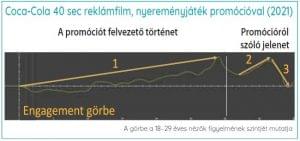
2nd example: XIXO – 20 s – Prize game with promotion (2020)
What does the engagement curve say? The story leading up to the promotion wasn’t interesting to 18-29 years old viewers and they completely lost their interest by the time the promotional scene was approaching. A questionnaire survey found that the commercial’s activation score was 32 percent.
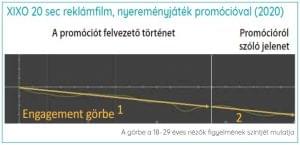
2.The content is easy to follow and understand
With commercials that focus on a promotion, Synetiq’s experience is that those promotional messages were able to reach viewers where verbal and visual elements say the same thing. It must also be taken into consideration that viewers tend to become tired by the end of even the most exciting commercial, so they can’t pay attention to the information they are hearing then. Therefore commercials that detail the promotion throughout should start with the biggest prize, while those advertisements that only communicate the promotion at the end should use short and simple narration.
1st example: Pöttyös Túró Rudi – 20 s – Promotional commercial (2020)
What does the engagement curve say? The question ‘What would you do with 5 million forints?’ was able to make 18-29 years old viewers interested instantly. The commercial was going from the main prize towards the smaller prizes, making sure that verbal and visual elements are in a balance throughout. In spite of this viewers became tired in the 9th second and started losing their attention. Still, the commercial’s activation score was 91 percent.
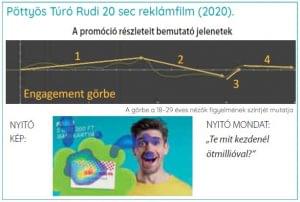
2nd example: Pápai Hús – 25 s – Promotional commercial (2021)
What does the engagement curve say? Although 18-59 years old viewers didn’t find the story leading up to the promotion very interesting, it was able to maintain their attention until the promotion scene. This scene didn’t go into details, it just communicated the most essential things instead: ‘Have a few bites and win a FIAT courtesy of Pápai!’ – the same information was also visualised on the screen. The balance between verbal and visual elements, plus the simple and understandable message resulted in an activation score of 78 percent.
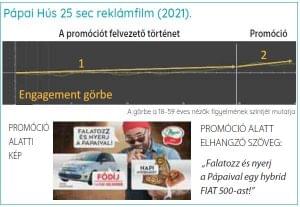
3.The promotional packshot is visually simple and leads the eyes of viewers well
It is worth keeping a few rules when it comes to the packshot ending the commercial. Besides the balance of verbal and visual elements, it is also very important to put the visual elements at the right places – and the ideal visual composition greatly depends on the length of the packshot. With a short, 3-4 second packshot it is the best if the most important information is placed in the centre. In the case of longer packshots more elements can be shown, as viewers have the time to process what they see.
1st example: Tippmix commercial’s packshot about the promotion (4 seconds)
2nd example: Auchan commercial’s packshot about the promotion (7 seconds)
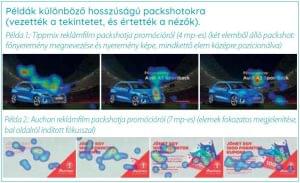
The following characteristics can make a television commercial successful:
1.The story leading up to the promotion scene must be interesting and engaging for the target group.
2. The story and the communication style must be relevant and credible for them!
3.If the whole commercial is about the promotion, it is best if the biggest prize comes at the beginning.
4. If the commercial’s last scene is about the promotion, communication should be simple.
5. Verbal and visual elements must be balanced for a better understanding. 6. The packshot’s visualisation should be simple and has to lead the focus well.
More information on neuromarketing methodology: www.synetiq.net. //
Related news
NKFH: Auchan recalled crumbled tarragon due to PAH content above the limit value
🎧 Hallgasd a cikket: Lejátszás Szünet Folytatás Leállítás Nyelv: Auto…
Read more >More than 30 tons of donations were collected in the Hungarian Red Cross and Auchan fundraising campaign
🎧 Hallgasd a cikket: Lejátszás Szünet Folytatás Leállítás Nyelv: Auto…
Read more >Coca-Cola changes CEO: COO takes the lead
🎧 Hallgasd a cikket: Lejátszás Szünet Folytatás Leállítás Nyelv: Auto…
Read more >Related news
Egg prices up nearly one-third
🎧 Hallgasd a cikket: Lejátszás Szünet Folytatás Leállítás Nyelv: Auto…
Read more >Layers of problems
🎧 Hallgasd a cikket: Lejátszás Szünet Folytatás Leállítás Nyelv: Auto…
Read more >Too many gifts, too much food: our holiday excesses are putting a serious strain on the environment
🎧 Hallgasd a cikket: Lejátszás Szünet Folytatás Leállítás Nyelv: Auto…
Read more >
